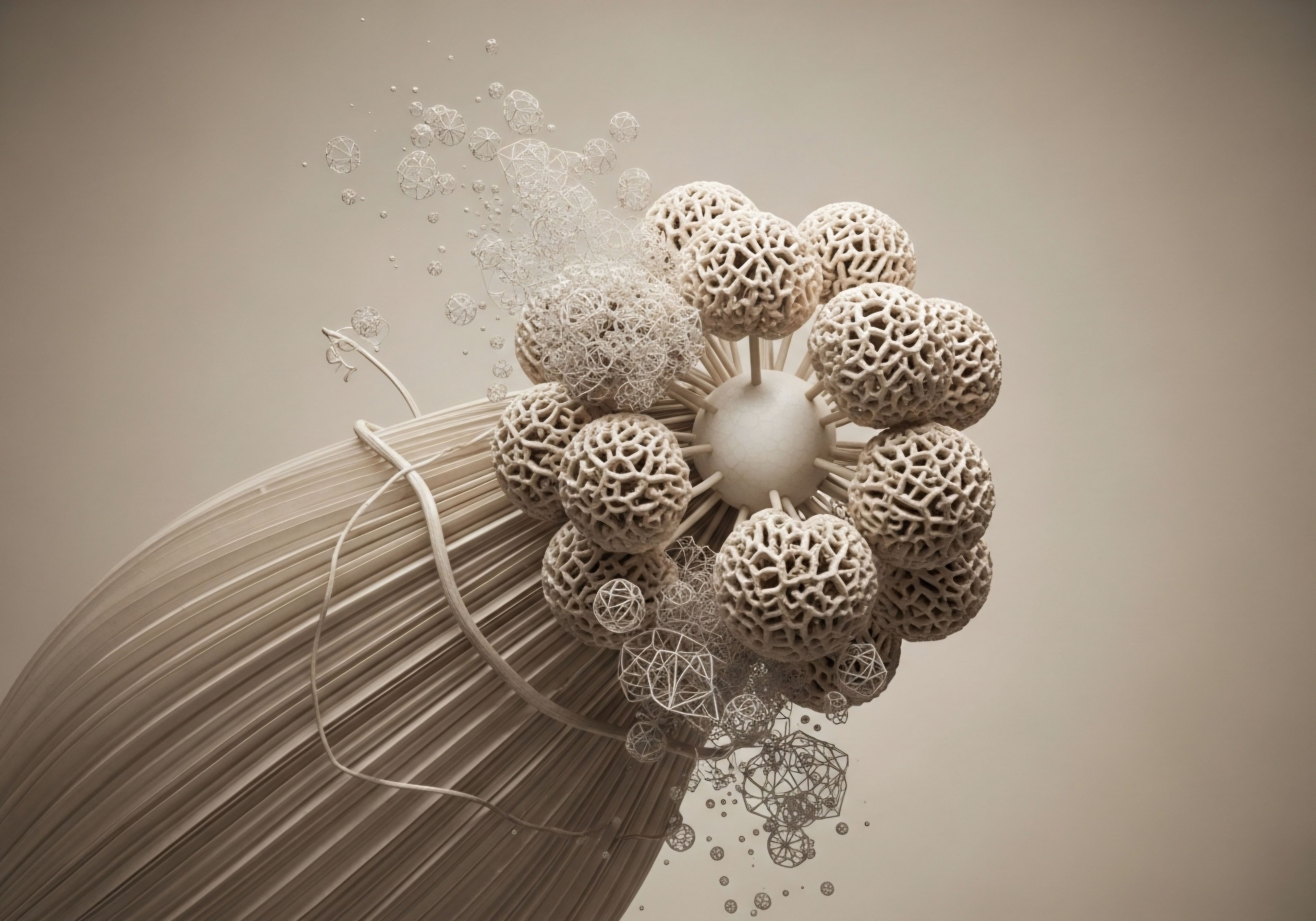

Fundamentals
The decision to discontinue testosterone replacement therapy often brings a unique set of concerns, particularly about the body’s capacity to restore its own internal balance. You might be experiencing a sense of uncertainty, perhaps a decline in energy, shifts in mood, or a general feeling that your system is searching for its previous rhythm.
These sensations are valid expressions of a complex biological recalibration underway. Your body, a remarkably adaptive system, is working to re-establish its intrinsic hormonal production after a period of external support. Understanding this intricate process is the first step toward reclaiming your vitality and function.
At the core of male hormonal regulation lies the Hypothalamic-Pituitary-Gonadal (HPG) axis, a sophisticated communication network. This axis functions much like a precise internal thermostat, constantly monitoring and adjusting hormone levels. The hypothalamus, located in the brain, initiates the signaling by releasing Gonadotropin-Releasing Hormone (GnRH). This chemical messenger travels to the pituitary gland, a small but mighty organ situated at the base of the brain.
The pituitary gland, upon receiving the GnRH signal, then secretes two crucial hormones ∞ Luteinizing Hormone (LH) and Follicle-Stimulating Hormone (FSH). These gonadotropins travel through the bloodstream to the testes, the primary male reproductive glands. LH acts directly on the Leydig cells within the testes, stimulating them to produce testosterone. FSH, conversely, targets the Sertoli cells, which are essential for supporting sperm development, a process known as spermatogenesis.
The body’s HPG axis acts as a central command, orchestrating the production of essential male hormones and supporting reproductive health.
When exogenous testosterone is introduced through TRT, the body’s HPG axis perceives sufficient testosterone levels circulating in the system. This perception triggers a negative feedback loop, signaling the hypothalamus and pituitary to reduce their output of GnRH, LH, and FSH. The testes, no longer receiving the necessary stimulatory signals from LH and FSH, consequently decrease their natural testosterone production and often experience a reduction in size and function. This suppression is a predictable physiological response to external hormone administration.
Cessation of TRT initiates a period where the HPG axis must reactivate. The goal of successful testicular recovery involves the restoration of endogenous testosterone production and, for many, the return of fertility. This reactivation requires the hypothalamus and pituitary to resume their normal signaling patterns, prompting the testes to regain their full capacity. Clinical markers serve as objective indicators of this recovery process, providing a clear roadmap of progress.

Initial Markers for Recovery Assessment
Monitoring specific biochemical markers provides a clear picture of the HPG axis’s return to activity. These initial measurements establish a baseline and allow for tracking the system’s response to therapeutic interventions. Regular blood tests are indispensable for this purpose, offering insights into the body’s internal state.
- Total Testosterone ∞ This measurement indicates the overall amount of testosterone circulating in the blood. During TRT cessation, initial levels will be low, reflecting the suppressed endogenous production. A successful recovery will show a progressive increase in this value.
- Free Testosterone ∞ Representing the biologically active portion of testosterone, this marker provides a more precise indication of available hormone for cellular function. Its rise mirrors the overall improvement in testicular output.
- Luteinizing Hormone (LH) ∞ A critical indicator of pituitary activity. Low or suppressed LH levels during TRT are expected. A healthy recovery is characterized by a significant rise in LH, signaling the pituitary’s renewed effort to stimulate the testes.
- Follicle-Stimulating Hormone (FSH) ∞ This hormone reflects the pituitary’s signaling to the Sertoli cells, crucial for spermatogenesis. An increase in FSH indicates the pituitary is attempting to restart sperm production.
- Estradiol (E2) ∞ Testosterone can convert into estrogen (estradiol) in the body. Monitoring estradiol levels is important because excessively high levels can also suppress the HPG axis, hindering recovery.
These foundational markers provide the initial framework for evaluating testicular recovery. Their trends over time, rather than single measurements, offer the most meaningful data. The journey toward recovery is a dynamic process, and consistent monitoring helps guide personalized protocols.


Intermediate
Navigating the period following testosterone replacement therapy requires a strategic approach to support the body’s natural systems. The aim is to gently coax the HPG axis back into full operation, rather than simply waiting for it to reactivate on its own. Specific pharmacological agents are employed to provide targeted stimulation, accelerating the recovery of endogenous hormone production and, when desired, fertility. These agents act at different points within the HPG axis, working synergistically to restore balance.

Pharmacological Support for Testicular Reactivation
The protocols for post-TRT recovery are designed to counteract the suppression induced by exogenous testosterone. Each medication plays a distinct role in stimulating the body’s intrinsic hormonal pathways. Understanding their mechanisms provides clarity on their application.
Gonadorelin, a synthetic analog of GnRH, directly stimulates the pituitary gland. Administered via subcutaneous injections, typically twice weekly, it prompts the pituitary to release LH and FSH. This direct stimulation bypasses any hypothalamic inhibition, providing a consistent signal to the testes. Its use helps to “wake up” the pituitary, preparing it to resume its natural signaling rhythm.
Tamoxifen and Clomid (clomiphene citrate) are selective estrogen receptor modulators (SERMs). They function by blocking estrogen receptors in the hypothalamus and pituitary. When these receptors are blocked, the brain perceives lower estrogen levels, even if actual circulating estrogen remains stable.
This perceived reduction in estrogen removes a key inhibitory signal on the HPG axis, prompting the hypothalamus to increase GnRH release and the pituitary to produce more LH and FSH. Tamoxifen and Clomid are often used in combination or sequentially, with dosages tailored to individual response. Clomid is frequently initiated at 25-50 mg daily or every other day, while Tamoxifen might be used at 10-20 mg daily.
Targeted medications can help reactivate the body’s hormone production system after TRT, encouraging natural balance.
Anastrozole, an aromatase inhibitor, works by blocking the enzyme aromatase, which converts testosterone into estrogen. While some estrogen is essential, excessive levels can suppress the HPG axis and contribute to unwanted side effects. Anastrozole, typically taken orally twice weekly, helps manage estrogen levels, creating a more favorable hormonal environment for testicular recovery. Its inclusion is often determined by monitoring estradiol levels, ensuring they remain within an optimal range for recovery without becoming too low.

Monitoring Progress with Advanced Markers
Beyond the foundational markers, a deeper analysis of specific biochemical indicators provides a more comprehensive view of recovery. These markers help refine treatment protocols and confirm the return of robust testicular function.
| Clinical Marker | Significance in Recovery | Expected Trend Post-TRT Cessation |
|---|---|---|
| Sex Hormone Binding Globulin (SHBG) | Protein that binds testosterone; influences free testosterone levels. | May initially decrease, then stabilize or increase as endogenous production resumes. |
| Prolactin | Pituitary hormone; high levels can suppress GnRH and gonadotropins. | Should remain within normal limits; elevated levels warrant investigation. |
| Inhibin B | Produced by Sertoli cells; a direct marker of spermatogenesis and Sertoli cell function. | Low during suppression; a significant rise indicates recovery of sperm production. |
| Semen Analysis | Direct assessment of sperm count, motility, and morphology. | Essential for fertility assessment; progressive improvement indicates successful spermatogenesis. |
The interplay of these markers paints a detailed picture of the recovery trajectory. A rising LH and FSH alongside increasing total and free testosterone indicates successful pituitary-testicular communication. A concurrent rise in Inhibin B and improvement in semen parameters confirms the restoration of spermatogenesis, a critical aspect of complete testicular recovery. The duration of TRT, individual physiology, and adherence to the recovery protocol all influence the timeline for these markers to normalize.

How Does the Body Recalibrate Its Hormonal Set Point?
The body’s hormonal system operates on a principle of dynamic equilibrium, constantly seeking a stable internal environment. When external testosterone is introduced, the HPG axis adjusts its “set point” for hormone production downwards. Upon TRT cessation, the system must reset this set point. This recalibration involves the hypothalamus and pituitary regaining their sensitivity to circulating hormone levels and re-establishing their appropriate pulsatile release of GnRH, LH, and FSH.
This process is not instantaneous; it requires time for the endocrine glands to desensitize from the exogenous input and resensitize to the body’s internal signals. The medications used in recovery protocols act as catalysts, helping to nudge the system back toward its original, or a new, healthy set point.
They provide the necessary signals to overcome the initial inertia of suppression, allowing the body’s intrinsic regulatory mechanisms to resume control. This return to self-regulation is the ultimate sign of successful recovery.


Academic
The restoration of testicular function following exogenous testosterone administration represents a fascinating interplay of neuroendocrine signaling, cellular adaptation, and genetic expression. A deep understanding of the underlying endocrinology reveals the precise mechanisms by which the HPG axis reasserts its control and the testes regain their capacity for steroidogenesis and spermatogenesis. This process is not merely a return to baseline; it involves a complex sequence of molecular events that can be influenced by individual physiological variations.

Molecular Endocrinology of Testicular Recovery
At the cellular level, the suppression induced by TRT impacts both the Leydig cells, responsible for testosterone production, and the Sertoli cells, which support germ cell development. During TRT, the sustained presence of exogenous testosterone leads to a downregulation of LH receptors on Leydig cells and a reduction in the enzymatic machinery required for testosterone biosynthesis, such as CYP17A1 and HSD17B3.
The Sertoli cells, dependent on FSH and high intratesticular testosterone, also experience reduced activity, impacting their ability to support spermatogenesis.
Upon TRT cessation, the removal of the negative feedback signal allows for a gradual increase in GnRH pulsatility from the hypothalamus. This increased pulsatility is critical, as the frequency and amplitude of GnRH pulses dictate the differential release of LH and FSH from the pituitary.
LH and FSH then stimulate their respective receptors on Leydig and Sertoli cells. The recovery involves the upregulation of these receptors and the restoration of the intracellular signaling cascades that lead to hormone synthesis and germ cell maturation.
The SERMs, such as Tamoxifen and Clomid, exert their effects by selectively binding to estrogen receptors (ERs) in the hypothalamus and pituitary. By acting as antagonists at these sites, they prevent estrogen from binding and exerting its negative feedback. This blockade effectively “tricks” the brain into perceiving lower estrogen levels, thereby disinhibiting GnRH, LH, and FSH secretion.
This mechanism highlights the delicate balance of estrogen’s role in male physiology; while essential in appropriate concentrations, excess estrogen or its unchecked feedback can be detrimental to testicular function.

Interplay with Metabolic Pathways and Systemic Health
Testicular recovery extends beyond the direct HPG axis, interacting with broader metabolic and systemic health parameters. Hormonal balance significantly influences insulin sensitivity, body composition, and inflammatory markers. Chronic inflammation, for instance, can impair Leydig cell function and reduce GnRH pulsatility, potentially hindering recovery. Similarly, suboptimal metabolic health, characterized by insulin resistance or excessive adiposity, can lead to increased aromatization of testosterone to estrogen, further complicating the re-establishment of endogenous production.
The process of recovery is thus not isolated; it is intertwined with the body’s overall metabolic efficiency. Optimizing factors such as diet, exercise, and sleep can support the endocrine system’s efforts to recalibrate. For instance, adequate sleep is known to influence GnRH pulsatility, and regular physical activity can improve insulin sensitivity, indirectly supporting hormonal equilibrium. A comprehensive approach to recovery considers these systemic connections, recognizing that the body functions as an integrated system.
Testicular recovery is a complex process involving cellular adaptation and systemic metabolic balance, not just hormonal shifts.

Genetic Predisposition and Individual Variability
Individual responses to TRT cessation and recovery protocols vary considerably. Genetic factors play a significant role in this variability. Polymorphisms in genes encoding hormone receptors (e.g. androgen receptor, estrogen receptor), enzymes involved in steroidogenesis (e.g. aromatase), or components of the HPG axis can influence the speed and completeness of recovery. For example, individuals with higher baseline aromatase activity might require more aggressive estrogen management during recovery.
The duration of TRT and the dosage administered also impact recovery time. Longer durations and higher doses typically lead to more profound and prolonged HPG axis suppression, necessitating a more extended and intensive recovery protocol. Age is another factor; younger individuals generally exhibit a more robust and rapid recovery capacity compared to older men, whose Leydig cell reserve and HPG axis responsiveness may be naturally diminished.
| Recovery Phase | Key Hormonal Changes | Cellular Adaptations | Clinical Implications |
|---|---|---|---|
| Initial Reactivation (Weeks 1-4) | LH/FSH begin to rise; Testosterone remains low, then slight increase. | Pituitary desensitization from exogenous T; Leydig cell receptor upregulation begins. | Symptoms of low T may persist or worsen; psychological support is important. |
| Progressive Recovery (Months 1-3) | LH/FSH continue to rise; Testosterone shows significant increase; Estradiol stabilization. | Leydig cell steroidogenesis enzymes reactivate; Sertoli cell function improves. | Improvements in energy, mood, and libido; initial signs of spermatogenesis return. |
| Sustained Function (Months 3-6+) | Testosterone, LH, FSH, Inhibin B normalize; Semen parameters improve. | Full restoration of Leydig and Sertoli cell function; stable HPG axis feedback. | Return to baseline vitality; fertility potentially restored; ongoing monitoring. |
The detailed understanding of these molecular and systemic interactions allows for a truly personalized approach to testicular recovery. By analyzing the complete clinical picture, including genetic predispositions and metabolic health, practitioners can tailor protocols to optimize outcomes, supporting the body’s inherent drive toward balance and function. This comprehensive perspective ensures that recovery is not just about numbers on a lab report, but about restoring overall well-being.

What Factors Influence the Speed of Testicular Recovery?
Several elements play a role in how quickly the testes regain their full function after TRT cessation. The duration of testosterone therapy is a primary consideration; individuals on TRT for many years often experience a more prolonged recovery period compared to those on therapy for a shorter time. The dosage of testosterone used during treatment also matters, with higher doses typically leading to greater suppression of the HPG axis.
An individual’s age significantly impacts recovery potential. Younger men generally possess a more robust and responsive HPG axis, allowing for a quicker return to endogenous production. Pre-existing conditions, such as primary hypogonadism or pituitary dysfunction, can also affect the ability of the testes to recover. Lifestyle factors, including nutrition, exercise, and stress management, contribute to the overall health of the endocrine system and can either support or hinder the recovery process.

References
- Bhasin, Shalender, et al. “Testosterone Therapy in Men With Androgen Deficiency Syndromes ∞ An Endocrine Society Clinical Practice Guideline.” Journal of Clinical Endocrinology & Metabolism, vol. 99, no. 11, 2014, pp. 3927-3945.
- Nieschlag, Eberhard, and Hermann M. Behre. Andrology ∞ Male Reproductive Health and Dysfunction. 3rd ed. Springer, 2010.
- Khera, Mohit, et al. “A Systematic Review of the Efficacy and Safety of Clomiphene Citrate in Male Hypogonadism.” Translational Andrology and Urology, vol. 4, no. 5, 2015, pp. 571-577.
- Swerdloff, Ronald S. and Christina Wang. “Androgens and the Aging Male.” Clinical Endocrinology and Metabolism, vol. 19, no. 3, 2005, pp. 675-690.
- Boron, Walter F. and Emile L. Boulpaep. Medical Physiology. 3rd ed. Elsevier, 2017.
- Paduch, Darius A. et al. “Testosterone Replacement Therapy and Fertility ∞ Is There a Compromise?” The Journal of Urology, vol. 192, no. 4, 2014, pp. 1244-1250.
- Shabsigh, Ridwan, et al. “Gonadotropin-Releasing Hormone Agonists and Antagonists in the Treatment of Prostate Cancer.” Urology, vol. 60, no. 5, 2002, pp. 746-753.
- Handelsman, David J. “Androgen Physiology, Pharmacology and Abuse.” Endocrine Reviews, vol. 26, no. 3, 2005, pp. 385-401.
- Guyton, Arthur C. and John E. Hall. Textbook of Medical Physiology. 14th ed. Elsevier, 2020.
- Hayes, F. John, et al. “The Role of Gonadotropin-Releasing Hormone in the Regulation of Gonadotropin Secretion in Men.” Journal of Clinical Endocrinology & Metabolism, vol. 84, no. 1, 1999, pp. 1-10.

Reflection
The journey of understanding your body’s hormonal systems is a deeply personal one, extending far beyond the cessation of a particular therapy. The knowledge you have gained about the HPG axis, the specific markers, and the therapeutic agents is not merely academic; it is a framework for self-awareness.
Consider this information a starting point, a guide to help you listen more closely to your body’s signals and collaborate effectively with your healthcare providers. Your path to optimal well-being is unique, shaped by your individual physiology and lived experiences. Proactive engagement with your health, armed with this deeper understanding, empowers you to reclaim your vitality and function without compromise.



